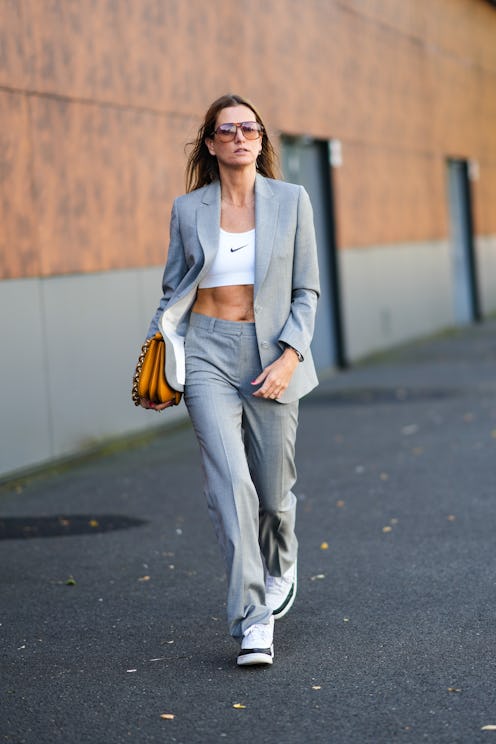(Innovation)
The Future Of The Sports Bra Is Here
And thankfully, it’s both inclusive and comfortable.

As someone who is light-to-medium chested, sports bras for me were more about aesthetics than they ever were practicality. Any style I put on would fit snugly enough against my chest to allow me to work out comfortably without too much concern for bouncing or sagging. But, over the years I’ve seen many friends find that their sports bra was the limiting factor in upping their workout routine. To comfortably run or even dance, they’d have to layer on multiple supportive sports bras at once to limit bounce, leaving them uncomfortably sweaty.
Despite innovations being made in shoe technology or in sweat-wicking materials, the simple mechanics of good chest support were slow to be addressed, leaving many women without a viable option. But recent innovations from major sports brands are finally bringing a more thoughtful (and inclusive) approach to support.
For starters, it’s no longer enough to design sports bras with a one-style-fits-all methodology. The low-impact needs of a woman in a yoga class are different from those of someone who is taking up running or a HIIT workout. And, since breasts come in such a wide variety of shapes and sizes, for the brands leading innovation within the industry, it’s been important to take the time to wear-test products on a wide range of women to make sure that designs fit the needs of someone with an A-cup as readily as they do someone with a DD or above.
But thoughtful innovation takes time. For Nike, investing in technical tools over the past few years has helped to guide a larger scope of transformation, namely through technology that allows for higher-volume wear-testing than would ever be possible just on individuals. The brand works with both Haley, a sweat mannequin (it produces sweat allowing designers to test thermal risks of clothing), and bra bot, the first-ever fully-instrumented soft tissue bra robot, to address the needs of its athletes. “Every time you put on a bra, it can change how you move,” Dr. Bridget Munro, Nike’s Women’s research director, explained at a May 18 panel exploring women’s design in tandem with Nike’s 50th anniversary. “If we want to assess the bra as an object, that’s why we built a robot, she’s very reliable and that helps us build consistency in our garments and our bras.”
While subbing humans for robots may not immediately strike you as a solution, Nike’s experts explain that it’s the ability to process data from consistent testing that has proved to push fit innovation. “The real breakthrough in better fitting apparel for more body types has been the proliferation of digital tools,” says Melissa Schirripa, vice president global apparel at Nike. “We’re using data visualization and avatars to more accurately match the wide range of curves, heights, and weights we all have. We’re not just grading up, we’re creating specific designs for a much larger percentage of our population to reinforce that sport will never be defined by size.”
But, Nike is not the only brand pushing innovation in the women’s space, specifically through sports bra development. Kate Warrington Williams, VP of women’s design at Lululemon cites the brand’s AirSupport bra which launched in July of 2021 as an example of the brand’s recent work. “We spent two years designing and testing [it] with our global collective of runners. The concept builds on five years of R&D exploring breast movement, movement management, and engineered sensation.”
For many sports bra wearers, cup and band sizing, as is usually found with traditional everyday bras, has not been part of the conversation. Instead, most labels have relied on one-dimensional sizing that may not address the specific needs of their body. “Every woman’s breasts move in a unique way,” says Warrington Williams. “It’s like a signature and completely individual to them. We consider this unique breast movement profile, in combination with personal feel preference, and of course, physical make-up and shape, to design and construct bras that not only meet functional needs but also deliver a completely new sensory experience that feels perfect for their chosen activity.”
Nike’s approach has been to hone in on three specific bra styles — each meant for a varying level of activity. “We’ve simplified our Nike bra strategy to let her choose by the style she loves first, and then support need,” Tania Flynn, vice president women’s apparel design at Nike said in the same panel. “Our three bra franchise families — the Alate, Indy, and Swoosh are now available in all levels of support — light, medium, and high. We now offer more than 70 cup sizes, and every new silhouette that the team designs will be available in ranges from extra small to 4X.”
For women who have never been able to find a bra fitted to their body and needs, these changes are not just about appearance or how the bra feels when they pull it on (though those things are both important elements), with technological advancements and prioritization of designing for a more diverse range of women’s bodies, there are fewer and fewer spaces in the workout space where women’s participation is limited because their needs aren’t being met. “For many of us, no bra means no sport, and I’m definitely in that category,” says Munro. “Think about the bra not just as an object, but [think about] what is the experience she needs to have with that bra so we can meet her where she is and her movement goals, in her preference and how she wants to feel.”
Keep scrolling to shop some of TZR’s favorite supportive (and cute!) sports bras of the moment.
We at TZR only include products that have been independently selected by our editors. We may receive a portion of sales if you purchase a product through a link in this article.
This article was originally published on